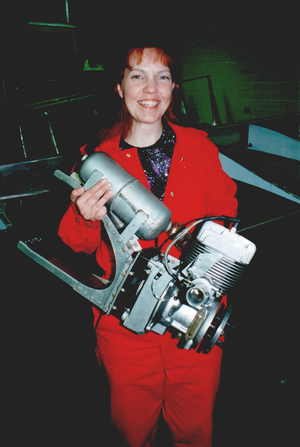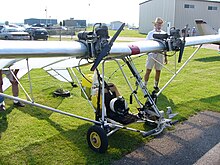
The Rotax 912 is a horizontally-opposed four-cylinder, naturally-aspirated, four-stroke aircraft engine with a reduction gearbox. It features liquid-cooled cylinder heads and air-cooled cylinders. Originally equipped with carburetors, later versions are fuel injected. Dominating the market for small aircraft and kitplanes, Rotax produced its 50,000th 912-series engine in 2014. Originally available only for light sport aircraft, ultralight aircraft, autogyros and drones, the 912-series engine was approved for certified aircraft in 1995.

The Rotax 582 is a 48 kW (64 hp) two-stroke, two-cylinder, rotary intake valve, oil-in-fuel or oil injection pump, liquid-cooled, gear reduction-drive aircraft engine manufactured by BRP-Rotax GmbH & Co. KG. It is for use in non-certified aircraft operating in day visual flight rules.

The UltraFlight Lazair is a family of Canadian designed and built twin-engine ultralight aircraft that were sold in kit form between 1979 and 1984.

The Rotax 503 is a 37 kW (50 hp), inline 2-cylinder, two-stroke aircraft engine, built by BRP-Rotax GmbH & Co. KG of Austria for use in ultralight aircraft.
The Rotax 447 is a 41.6 hp (31 kW), inline 2-cylinder, two-stroke aircraft engine, built by BRP-Rotax GmbH & Co. KG of Austria for use in ultralight aircraft.
The Rotax 377 is a 35 hp (26 kW), twin-cylinder, two-stroke aircraft engine, that was built by BRP-Rotax GmbH & Co. KG of Austria for use in ultralight aircraft.
The Rotax 532 is a 48 kW (64 hp) two-stroke, two-cylinder, rotary valve engine, liquid-cooled, gear reduction-drive engine that was formerly manufactured by BRP-Rotax GmbH & Co. KG. It was designed for use on ultralight aircraft.
The Rotax 618 is a 73.8 hp (55 kW) two-stroke, two-cylinder, liquid cooled, gear reduction-drive engine that was formerly manufactured by BRP-Rotax GmbH & Co. KG. It was designed for use on ultralight aircraft.
The Hirth F-23 is a twin cylinder, horizontally-opposed, two stroke, carburetted or optionally fuel injected aircraft engine designed for use on ultralight aircraft. It is manufactured by Hirth of Germany.
The Hirth F-30 is a horizontally opposed four-cylinder, two-stroke, carburetted aircraft engine, with optional fuel injection, designed for use on ultralight aircraft and homebuilts. It is manufactured by Hirth of Germany.
The Hirth 3202 and 3203 are a family of in-line twin cylinder, two stroke, carburetted aircraft engines, with optional fuel injection, designed for use on ultralight aircraft, especially two seat ultralight trainers, gyrocopters and small homebuilts. It is manufactured by Hirth of Germany.
The Zenoah G-25 is a single cylinder, two stroke, carburetted aircraft engine, with optional fuel injection, designed for use on ultralight aircraft
The Zenoah G-50 is a twin-cylinder, horizontally opposed, two stroke, carburetted aircraft engine, designed for use on ultralight aircraft.

The HKS 700E is a twin-cylinder, horizontally opposed, four stroke, carburetted aircraft engine, designed for use on ultralight aircraft, powered parachutes and ultralight trikes. The engine is manufactured by HKS, a Japanese company noted for its automotive racing engines.
The Kawasaki 440, also called the T/A 440, is a Japanese twin-cylinder, in-line, two-stroke engine that was designed for snowmobiles and produced by Kawasaki Heavy Industries until the early 1980s.
The 2si 460 is a family of in-line twin-cylinder, two-stroke, single ignition, aircraft engines that were designed for ultralight aircraft.
The Arrow 250 is a family of single-cylinder, two-stroke, single- or dual-ignition aircraft engines that were designed for ultralight aircraft by Arrow SNC of Italy.
The Kawasaki 340 is a Japanese twin-cylinder, in-line, two-stroke engine that was designed for snowmobiles and produced by Kawasaki Heavy Industries until the early 1980s. The engine was available in air-cooled and liquid-cooled versions.
The Skye Treck Skyseeker is a Canadian ultralight aircraft that was designed and produced by Skye Treck of Manitoba. The aircraft was supplied as a kit for amateur construction.
The Diesel Air Dair 100 is an opposed-piston diesel aircraft engine, designed and produced by Diesel Air Ltd of Olney, Buckinghamshire for use in airships, home-built kitplanes and light aircraft. The prototype was built in the 1990s and exhibited it at PFA airshows. Although Diesel Air engines have been fitted to an AT-10 airship and to a Luscombe 8A monoplane, production numbers have been very limited.






